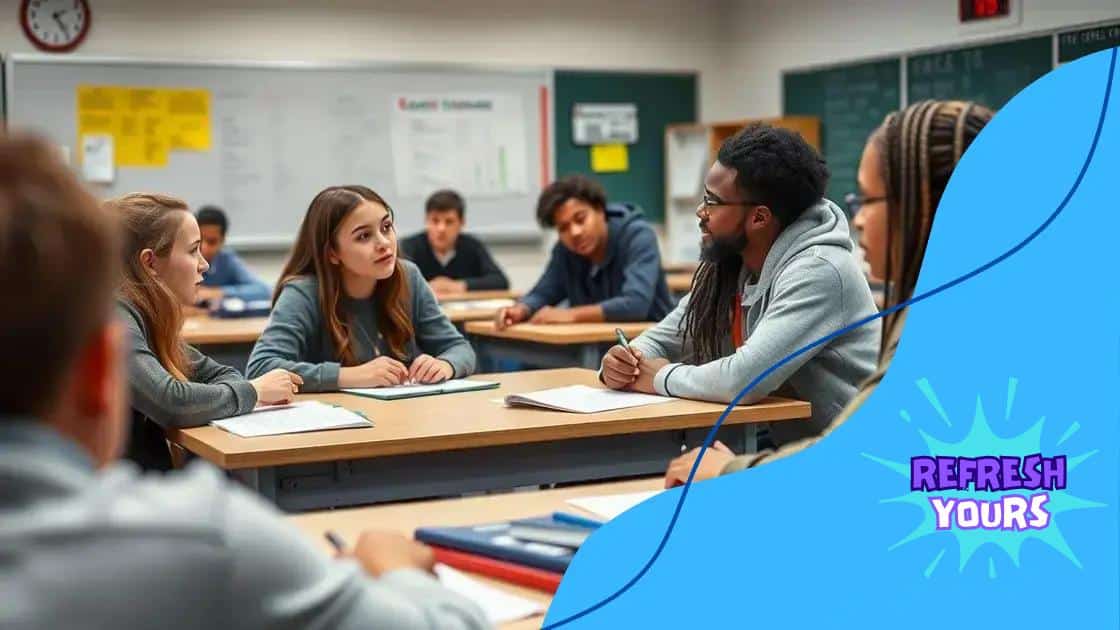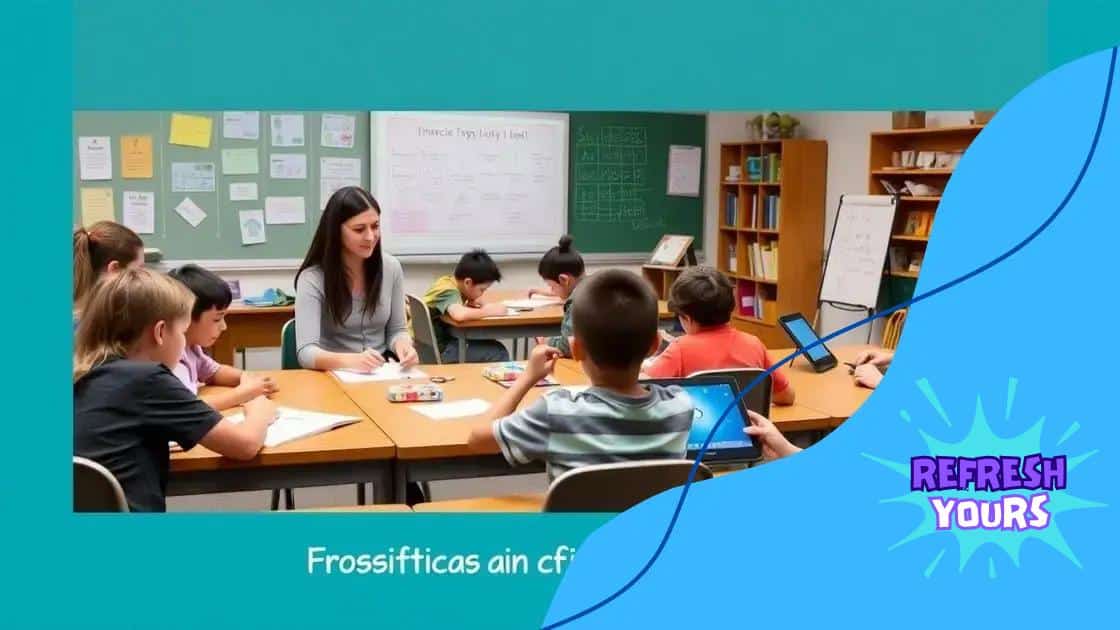How to incorporate financial education into high school programs

Incorporating financial education into high school programs equips students with essential skills for managing personal finances, preparing them for informed decision-making in real-life financial situations.
How to incorporate financial education into high school programs can equip students with vital skills for their futures. Imagine being ready to tackle real-world finance issues; it’s a critical pathway for youth today. Let’s dive into how schools can make this happen.
Understanding the importance of financial literacy
Understanding the importance of financial literacy is crucial for high school students. It prepares them for making informed financial decisions that will impact their lives. Without this knowledge, young adults may struggle with essential tasks like budgeting, saving, and investing.
Why Financial Literacy Matters
Many students leave high school without any knowledge of managing their finances. Financial literacy affects every aspect of life from purchasing a car to planning for retirement.
- Helps students make wiser spending choices.
- Encourages saving for emergencies and future goals.
- Aids in understanding debt and how to manage it.
- Prepares students for financial responsibilities in adulthood.
Financial literacy isn’t just about money; it promotes critical thinking. Students learn to analyze different options before making a purchase or investment. This skill is essential in a world full of financial choices.
Real-World Applications
Students who grasp the importance of financial literacy can better navigate financial products like bank accounts, credit cards, and loans. Understanding interest rates and fees can save them money in the long run.
Moreover, schools that incorporate financial education into their curriculum often report increased student engagement. When students see the real-world applications of their lessons, they become more invested in their education. By recognizing the connection between classroom lessons and daily life, students can appreciate the value of becoming financially educated.
Key topics to cover in financial education
When developing a comprehensive financial education program, it’s vital to cover key topics that will truly benefit students. These subjects will lay the foundation for a lifetime of sound financial decisions. A strong curriculum should include a variety of areas from budgeting to investing.
Essential Topics for Financial Education
One of the most important components of financial education is teaching students how to create and maintain a budget. Understanding where their money goes each month enables them to make informed choices about expenses. In addition, they should learn about the importance of saving.
- Budgeting basics and creating a personal budget
- Understanding savings accounts and interest
- Managing debt and understanding credit scores
- Introduction to investing and building wealth
These topics provide a solid groundwork for students. By understanding budgeting, they can plan for inevitable expenses and emergencies. Additionally, learning about savings teaches them to prioritize long-term goals over immediate gratification.
The Importance of Credit
Another crucial area of focus is understanding credit. Students should know how credit works, including why it’s important. By grasping topics like credit scores and reports, they can make better decisions regarding loans and credit cards in the future.
Investing is also a valuable topic. Students should learn the basics of stocks, bonds, and mutual funds. By understanding how investments grow over time, they can develop an interest in building wealth.
Overall, covering these key topics fully prepares students to face real-world financial situations. These lessons create confident young adults who can navigate their financial futures successfully.
Methods for teaching financial concepts effectively

Teaching financial concepts effectively is crucial for ensuring that students grasp the essential skills they need for lifelong financial success. Using various methods keeps students engaged and helps them learn better. Different approaches suit different learning styles, making it important to mix strategies during lessons.
Interactive Learning Techniques
One way to teach financial concepts is through interactive learning. By using games and simulations, students can experience real-life financial decision-making in a fun environment. Activities such as budgeting games or investment simulations can capture students’ attention and encourage participation.
- Incorporating role-playing scenarios to make decisions.
- Using team competitions focused on budgeting and saving.
- Encouraging group discussions about financial strategies.
- Integrating technology like financial education apps.
Another effective method is project-based learning. Students can tackle real-world projects, such as creating a personal budget or planning a small business. This hands-on approach helps solidify their understanding of financial principles while developing problem-solving skills.
Utilizing Technology in Teaching
Technology can also play a significant role in teaching financial concepts. Online resources, including videos and interactive platforms, can make complex topics easier to understand. For example, budgeting tools or investment calculators can provide students with practical experiences.
Combining traditional teaching methods with new technology allows for a more comprehensive learning experience. By providing students with a variety of resources, they can discover how to apply financial concepts in different aspects of their lives.
Ultimately, a mix of interactive approaches and technology creates a dynamic learning environment. Various methods cater to multiple learning styles, ensuring every student has the chance to understand and apply financial education meaningfully.
Engaging students through interactive activities
Engaging students through interactive activities is an effective way to make financial education more appealing. When lessons are hands-on, students are more likely to remember the concepts being taught. Interaction helps to foster curiosity and relate financial topics to their personal lives.
The Power of Hands-On Learning
One way to engage students is through simulations that mimic real-life financial situations. For example, a classroom activity where students create a budget for a mock event can illustrate the importance of money management.
- Setting up a mock store where students practice spending.
- Using role-playing scenarios to practice financial decision-making.
- Creating competitions where students can earn points for budgeting successfully.
- Implementing technology and apps to track personal finance.
These activities can turn abstract concepts into tangible experiences. When students actively participate, they gain firsthand knowledge and feel more connected to the material.
Utilizing Games and Quizzes
Games can also be an excellent method for teaching financial concepts. By incorporating games, teachers can motivate students to learn while having fun. For example, finance-related board games or online quizzes can introduce competition and excitement into the classroom.
Quizzes can help students assess their understanding of financial topics. When students answer questions correctly, it reinforces their knowledge and encourages them to engage further with the material. Prizes or small incentives can make learning more rewarding.
Ultimately, blending various interactive activities creates an engaging and enjoyable learning environment. When students are involved in the process, they are more likely to grasp important financial concepts and apply them in real life.
Resources and tools for financial educators
Resources and tools for financial educators play a crucial role in delivering effective financial education. With the right materials, educators can enhance their teaching and provide students with valuable knowledge. Various resources exist to help facilitate financial discussions and activities in the classroom.
Important Resources for Educators
Printed materials such as textbooks and workbooks offer structured information about managing personal finances. Websites with lesson plans and teaching guides can ease the preparation process. Many organizations provide free or low-cost resources tailored specifically for teaching financial literacy.
- Online platforms offering interactive lesson plans and activities.
- Websites with downloadable worksheets focused on budgeting and saving.
- Non-profit organizations that provide free financial education resources.
- Local community initiatives that offer workshops and materials.
Incorporating multimedia resources can also be beneficial. Videos, podcasts, and online courses can engage students and provide them with different perspectives on financial concepts. These tools can help break down complex topics into easier-to-understand segments. Moreover, students often gravitate toward technology-based learning.
Technology Tools
Apps and online tools are essential in modern education. Financial apps can help students track their spending, create budgets, and set savings goals. By using these tools, students can manage their finances in a practical way. Incorporating technology into lessons ensures that students have real-world applications to reference.
Additionally, having access to data visualization tools helps students understand financial trends and statistics better. Teachers can show how to analyze data, which is an important skill in today’s data-driven world.
Overall, a combination of printed materials, multimedia resources, and technology tools equips educators to teach financial concepts effectively. With these resources, students gain the knowledge necessary to navigate their financial futures confidently.
FAQ – Frequently Asked Questions about Financial Education in High Schools
Why is financial education important for high school students?
Financial education helps students develop essential money management skills, preparing them for real-life financial decisions and responsibilities.
What resources are available for teaching financial concepts?
Educators can access textbooks, online materials, community programs, and interactive tools to enhance their financial education curriculum.
How can interactive activities engage students in financial education?
Interactive activities, like simulations and games, make learning fun and help students understand financial concepts by putting them into practice.
What technology tools can be used in financial education?
Apps for budgeting and financial tracking, as well as online platforms for learning and simulations, can provide hands-on experience for students.





